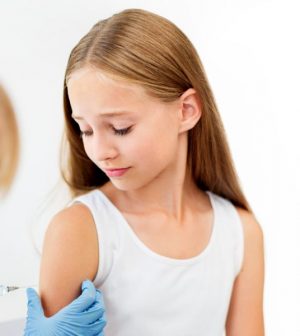- Navigating Your Midlife Crisis: Embracing New Possibilities
- City Raccoons Showing Signs of Domestication
- Mapping the Exposome: Science Broadens Focus to Environmental Disease Triggers
- One Week Less on Social Media Linked to Better Mental Health
- Your Brain Changes in Stages as You Age, Study Finds
- Some Suicide Victims Show No Typical Warning Signs, Study Finds
- ByHeart Formula Faces Lawsuits After Babies Sickened With Botulism
- Switch to Vegan Diet Could Cut Your Greenhouse Gas Emissions in Half
- Regular Bedtime Does Wonders for Blood Pressure
- Dining Alone Could Mean Worse Nutrition for Seniors
More Evidence HPV Vaccine Cuts Cervical Cancer Rate

Scotland is already seeing a payoff for vaccinating adolescent girls for human papillomavirus (HPV).
Since the vaccine became routine about a decade ago, cervical cancer cases in young Scottish women have plummeted, a new study reports.
HPV is one of the most common sexually transmitted infections. Vaccination protects against HPV types 16 and 18, which cause 70% of cervical cancer cases worldwide.
In 2008, Scotland began a national HPV immunization program. The vaccine, which protects against HPV 16 and 18, has become routine for girls aged 12 and 13, and a catch-up program is offered up to age 18.
The impact of routine vaccination on a large population had been unclear, according to Tim Palmer of the University of Edinburgh and his colleagues. Palmer is Scottish clinical lead for cervical screening.
So, the researchers looked at vaccination and screening records for nearly 139,000 women born between 1988 and 1996 who had a cervical screening test result recorded at age 20.
Specifically, the investigators looked at levels of abnormal cells and cervical lesions, known as cervical intraepithelial neoplasia (CIN). CIN is divided into grades: CIN1, 2 or 3. The higher the number, the greater the risk of invasive cervical cancer.
The findings were published April 3 in the BMJ.
Compared with unvaccinated women born in 1988, vaccinated women born in 1995 and 1996 had an 89% reduction in CIN grade 3 or worse; an 88% reduction in CIN grade 2 or worse; and a 79% reduction in CIN grade 1, the researchers reported in a journal news release.
The younger the age at vaccination, the more effective the vaccine, the findings showed. There was an 86% reduction in CIN grade 3 for women vaccinated at age 12 or 13, compared with 51% for those vaccinated at age 17.
Unvaccinated women also showed a reduction, possibly due to what is known as “herd protection,” the study authors said. In herd protection, vaccines provide some protection for those who don’t receive a shot, because fewer germs are being transmitted from person to person.
The findings show that routine immunization with the bivalent HPV vaccine is highly effective against high-grade cervical disease, Palmer’s team said.
“The findings emphasize the credibility of using high-risk HPV infection as an early marker of the effectiveness and success of the vaccine and underpin the recent call for global action on cervical cancer from the World Health Organization,” the authors concluded.
In an accompanying journal editorial, Julia Brotherton called the study results “dramatic.” She’s medical director at VCS Foundation in Australia.
“We must work towards a world in which all girls and their families are offered, and the majority accept, HPV vaccination, wherever they live,” Brotherton wrote. “We must also actively develop, resource, and scale-up more effective, feasible and culturally acceptable strategies for cervical screening, such as self-collection of specimens, if we are ever to effectively reduce the global burden of cervical cancer.”
More information
The U.S. Centers for Disease Control and Prevention has more on HPV vaccination.
Source: HealthDay
Copyright © 2025 HealthDay. All rights reserved.










